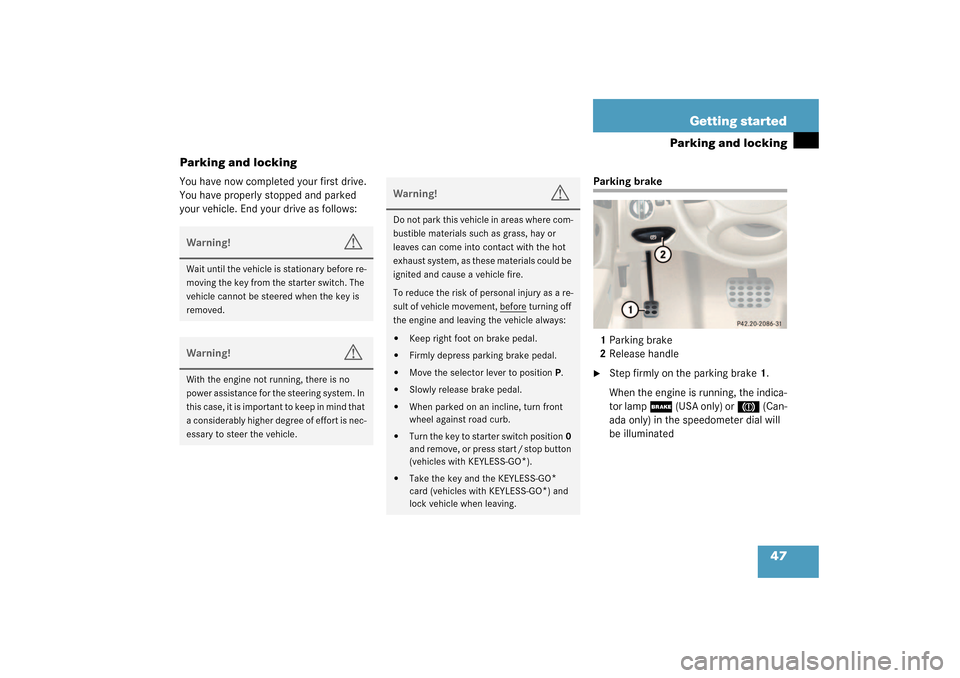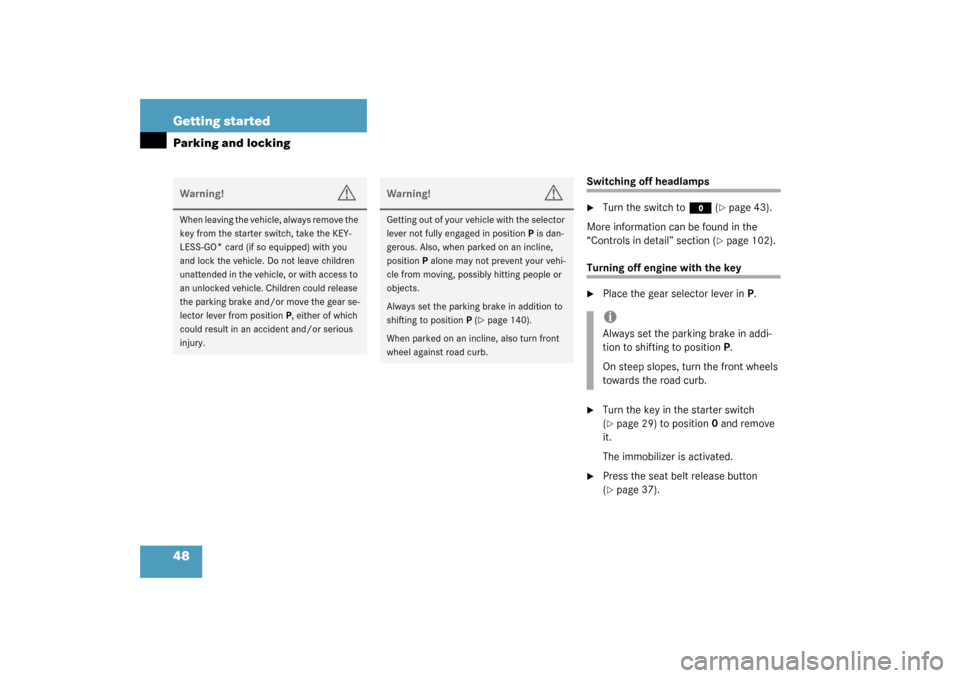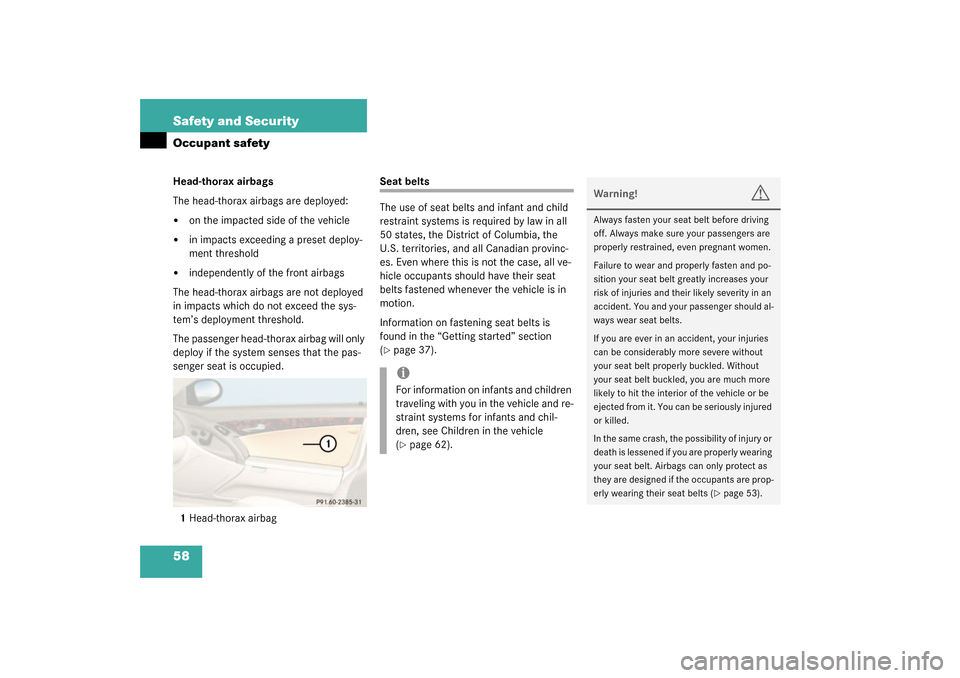Page 45 of 376

45 Getting started
Driving
Wiping with windshield washer fluid�
Push switch in the direction of arrow1
past the resistance point.
The windshield wiper operates with
washer fluid.
Information on filling up the washer reser-
voir can be found in the "Operation" sec-
tion (�page 233).
Problems while driving
The engine runs erratically and misfires�
An ignition cable may be damaged.
�
The engine electronics may not be op-
erating properly.
�
Unburned gasoline may have entered
the catalytic converter and damaged it.
�
Give very little gas.
�
Have the problem repaired by an au-
thorized Mercedes-Benz Center as
soon as possible.
The coolant temperature gauge is over
248°F (120°C)
The coolant is too hot and is no longer
cooling the engine.
�
Stop the vehicle as soon as possible
and turn off the engine. Allow engine
and coolant to cool.
�
Check the coolant level and add cool-
ant if necessary (
�page 230).
!If leaves, snow, etc. block the wind-
shield wipers, the wiper motor turns
off.�
For safety reasons, withdraw key
from starter switch. Remove block-
age.
�
Turn the windshield wipers on
again.
If windshield wipers fail to function at
all in switch positionI,
�
set the combination switch to the
next highest wiper speed.
�
have the windshield wipers
checked at the nearest authorized
Mercedes-Benz Center.
Page 46 of 376
46 Getting startedDrivingIn case of accident
If the vehicle is leaking gasoline:�
Do not start the engine under any cir-
cumstances.
�
Notify local fire and/or police authori-
ties.
If the extent of the damage cannot be de-
termined:
�
Notify an authorized Mercedes-Benz
Center.
If no damage can be determined on the
�
major assemblies
�
fuel system
�
engine mount:
�
Start the engine in the usual manner.
Page 47 of 376

47 Getting started
Parking and locking
Parking and locking
You have now completed your first drive.
You have properly stopped and parked
your vehicle. End your drive as follows:
Parking brake
1Parking brake
2Release handle�
Step firmly on the parking brake1.
When the engine is running, the indica-
tor lamp
;
(USA only) or
3
(Can-
ada only) in the speedometer dial will
be illuminated
Warning!
G
Wait until the vehicle is stationary before re-
moving the key from the starter switch. The
vehicle cannot be steered when the key is
removed.Warning!
G
With the engine not running, there is no
power assistance for the steering system. In
this case, it is important to keep in mind that
a considerably higher degree of effort is nec-
essary to steer the vehicle.
Warning!
G
Do not park this vehicle in areas where com-
bustible materials such as grass, hay or
leaves can come into contact with the hot
exhaust system, as these materials could be
ignited and cause a vehicle fire.
To reduce the risk of personal injury as a re-
sult of vehicle movement, before
turning off
the engine and leaving the vehicle always:
�
Keep right foot on brake pedal.
�
Firmly depress parking brake pedal.
�
Move the selector lever to positionP.
�
Slowly release brake pedal.
�
When parked on an incline, turn front
wheel against road curb.
�
Turn the key to starter switch position0
and remove, or press start / stop button
(vehicles with KEYLESS-GO
*).
�
Take the key and the KEYLESS-GO
*
card (vehicles with KEYLESS-GO
*) and
lock vehicle when leaving.
Page 48 of 376

48 Getting startedParking and locking
Switching off headlamps�
Turn the switch to
M
(�page 43).
More information can be found in the
“Controls in detail” section (
�page 102).
Turning off engine with the key�
Place the gear selector lever inP.
�
Turn the key in the starter switch
(�page 29) to position0 and remove
it.
The immobilizer is activated.
�
Press the seat belt release button
(�page 37).
Warning!
G
When leaving the vehicle, always remove the
key from the starter switch, take the KEY-
LESS-GO
* card (if so equipped) with you
and lock the vehicle. Do not leave children
unattended in the vehicle, or with access to
an unlocked vehicle. Children could release
the parking brake and/or move the gear se-
lector lever from positionP, either of which
could result in an accident and/or serious
injury.
Warning!
G
Getting out of your vehicle with the selector
lever not fully engaged in positionP is dan-
gerous. Also, when parked on an incline,
positionP alone may not prevent your vehi-
cle from moving, possibly hitting people or
objects.
Always set the parking brake in addition to
shifting to positionP (
�page 140).
When parked on an incline, also turn front
wheel against road curb.
iAlways set the parking brake in addi-
tion to shifting to positionP.
On steep slopes, turn the front wheels
towards the road curb.
Page 49 of 376

49 Getting started
Parking and locking
�
After exiting the vehicle, press the lock
button
‹
on the remote control
(
�page 28).
The locking knobs on the doors move
down.
More information can be found in the
“Controls in detail” section (
�page 80).
Turning off engine with KEYLESS-GO* �
Place the gear selector lever inP.
�
Press the KEYLESS-GO start/stop but-
ton until the engine shuts off.
With the driver's door closed, the start-
er switch is now in the position1. With
the driver's door opened, the starter
switch is set to position0, same as key
removed from starter switch
(�page 29).
�
Press the seat belt release button
(�page 37).
!If you hear a warning signal you have ei-
ther�
forgotten to turn off the lights, or
�
not put the gear selector lever inP
before opening the driver’s door.
Turn off the lights or place the gear se-
lector lever inP.
Warning!
G
To prevent possible personal injury, always
keep hands and fingers away from the door
openings when closing the doors. Be espe-
cially careful when small children are
around.
Before closing doors, make sure that there
is no possibility of someone getting caught
in a door during closing.
!If you hear a warning signal you have ei-
ther�
forgotten to turn off the lights, or
�
not put the gear selector lever inP
before opening the driver’s door.
Turn off the lights or place the gear se-
lector lever inP.
Warning!
G
To prevent possible personal injury, always
keep hands and fingers away from the door
openings when closing the doors. Be espe-
cially careful when small children are
around.
Before closing doors, make sure that there
is no possibility of someone getting caught
in a door during closing.
Page 50 of 376
50 Getting startedParking and locking1Lock button on the door handle�
After exiting the vehicle, press the lock
button1 on the door handle.
The locking knobs on the doors move
down.
More information can be found in the
“Controls in detail” section (
�page 80).
Emergency engine shut-down
If the engine cannot be turned off as de-
scribed, you may use the following backup
procedure.�
Open the main fuse box (
�page 329).
�
Pull out the two fuses labeled “ENGINE
EMERGENCY STOP” (
�page 329).
Warning!
G
When leaving the vehicle, always remove the
key from the starter switch, take the
KEYLESS-GO
* card (if so equipped) with
you, and lock your vehicle. Do not leave chil-
dren unattended in the vehicle, or with ac-
cess to an unlocked vehicle. Unsupervised
use of vehicle equipment may cause an ac-
cident and/or serious personal injury.
Page 52 of 376

52 Safety and SecurityOccupant safety
Occupant safetyIn this section you will learn the most im-
portant facts about the restraint systems
of the vehicle.
The restraint systems are�
Seat belts
�
Emergency tensioning device
�
Airbags
�
Child seats
�
Child seat recognition
As independent systems their protective
effects work in conjunction with each oth-
er.The
1
warning lamp in the instrument
cluster lights up for about 4 seconds when
you turn the key in the starter switch to po-
sition 1 or 2, or press the KEYLESS-GO* (if
so equipped) start/stop button once or
twice. It goes out when you start the en-
gine. This shows that the restraint systems
are operational.
If the lamp does not come on at all or if it
fails to extinguish after approximately 4
seconds or if it comes on thereafter, a mal-
function in the system has been detected.
More information can be found in the
"Practical hints" section (
�page 252).
iFor information on infants and children
traveling with you in the vehicle and re-
straint systems for infants and chil-
dren, see “Children in the vehicle”
(�page 62).
Warning!
G
In the event that the SRS malfunction indica-
tor lamp lights up during driving or does not
come on at all, the SRS may not be opera-
tional. For your safety, we strongly recom-
mend that you visit an authorized
Mercedes-Benz Center immediately to have
the system checked; otherwise the SRS may
not be activated when needed in an acci-
dent, which could result in serious or fatal
injury, or it might deploy unexpectedly and
unnecessarily which could also result in inju-
ry.
Improper work on the restraint systems can
lead to unintentional deployment or opera-
tional failure.
In addition, through improper work there is
a risk of rendering the SRS inoperative or
causing unintended airbag deployment.
Work on the SRS must therefore only be per-
formed by an authorized Mercedes-Benz
Center.
Page 58 of 376

58 Safety and SecurityOccupant safetyHead-thorax airbags
The head-thorax airbags are deployed: �
on the impacted side of the vehicle
�
in impacts exceeding a preset deploy-
ment threshold
�
independently of the front airbags
The head-thorax airbags are not deployed
in impacts which do not exceed the sys-
tem’s deployment threshold.
The passenger head-thorax airbag will only
deploy if the system senses that the pas-
senger seat is occupied.
1Head-thorax airbag
Seat belts
The use of seat belts and infant and child
restraint systems is required by law in all
50 states, the District of Columbia, the
U.S. territories, and all Canadian provinc-
es. Even where this is not the case, all ve-
hicle occupants should have their seat
belts fastened whenever the vehicle is in
motion.
Information on fastening seat belts is
found in the “Getting started” section
(�page 37).iFor information on infants and children
traveling with you in the vehicle and re-
straint systems for infants and chil-
dren, see Children in the vehicle
(�page 62).
Warning!
G
Always fasten your seat belt before driving
off. Always make sure your passengers are
properly restrained, even pregnant women.
Failure to wear and properly fasten and po-
sition your seat belt greatly increases your
risk of injuries and their likely severity in an
accident. You and your passenger should al-
ways wear seat belts.
If you are ever in an accident, your injuries
can be considerably more severe without
your seat belt properly buckled. Without
your seat belt buckled, you are much more
likely to hit the interior of the vehicle or be
ejected from it. You can be seriously injured
or killed.
In the same crash, the possibility of injury or
death is lessened if you are properly wearing
your seat belt. Airbags can only protect as
they are designed if the occupants are prop-
erly wearing their seat belts (
�page 53).